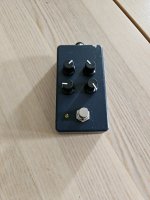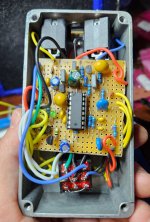- Build Rating
- 5.00 star(s)
First, here's a quick and dirty demo video I made:
Description of The Circuit
This is "a PT2399 based delay with envelope controlled pitch modulation that does chorus, vibrato, doubling, or slap-back delay" created by Aleph Null (original post on the madbean forum here). After viewing their demo video and looking at the vero layout, I was set on making my own version of this pedal. I love a good doubler/slapback sound for thickening up solos and riffs, and I figured it would be nice to have a dedicated effect for this very purpose. (I don't like fiddling with the settings on my delay pedal in the middle of a performance.)
Build Process
I made this directly from the vero layout provided by Aleph Null. It was an exceptionally simple build, and all of the parts are things many DIYers will already have on hand or will be able to obtain with ease. In general, building pedals on vero has been mostly fine for me.
There have been a few cases where vero didn't work out because of the size/complexity of the overall circuit. That's definitely not the case here. There's plenty of space to place components, there aren't too many cuts or links that are needed, and the layout is small enough to fit inside of a 1590B.
Quick note for anyone considering making this pedal: the vero displays a "100nf" electrolytic capacitor, when it should actually be labeled "100uf."
Modifications
I'm not at the point in this hobby where I can confidently identify what parts of a circuit would lend themselves to modification. Nonetheless, I made a few tweaks based on some feedback provided to me by Aleph Null. First, I switched out the B2k "Detune" pot for a B5k. This enables more wacky pitch-bending action with the "Detune" knob. I chose to do this because I play single-coil guitars, and more intense pitch-bending is triggered the harder you strum/pluck/pick. A B2k pot will probably work just fine if you're driving a louder signal into this pedal than I am.
In addition to this, I tried another modification that Aleph Null suggested. The additional gain on tap via the "Boost" knob is excellent, but I wanted to figure out a way to tap into that gain without increasing the overall volume very much (like a Speaker Cranker/Electra pedal). I've been especially inspired by the Rec Head pedal by Bleak District Electric and was hoping to turn the "Boost" knob into more a "Saturation" knob. Aleph Null suggested removing the 100k resistor before the Output and adding in some diodes front-to-back. I looked at a schematic for the Speaker Cranker and tried to copy-paste that into my build. I still get a fair bit of volume boost, so I didn't get the effect I was hoping for. I may return to this another time and try to modify it more, but I'm nonetheless happy with how the pedal sounds.
Enclosure Design
So enclosure design is the part of making pedals that I enjoy the least. Drilling and getting all of the parts into the enclosure is already hard enough for me as it is, and when I get to the point where I know a circuit works and sounds good to me, I'm usually driven to simply box it up as fast as possible. Most of my pedals are bare aluminum enclosures. However, I wanted to take the time to make this look a teeny bit nicer than my usual pedal. (Spoiler: I messed up quite a bit throughout this process).
The first error that I made had to do with the I/O and 9v drill holes. Given how poorly I spaced the drill holes out (even after doing my best to take precise measurements), I had to sand down portions of the jacks themselves to make it all fit. In the end, the jacks are all so close that I have to be very careful with which cables I use to plug into this pedal. If I use pancake jacks, then getting the power connected requires squeezing things in pretty tight.
In addition to messing up those drill holes, the holes I drilled for the pots came out quite uneven. I'm inclined to think that my drilling is the issue (rather than the marking/measurement). I've been using a step drill bit with a power drill. I imagine a drill press would give me a much better result.
Finally, I completely messed up the paint job that I was at one point very pleased with. I thought the paint and clear coat had dried enough for me to box up the circuit. Unfortunately I was wrong. The paint got scuffed up, and so I tried to patch things up by spray painting and clear coating again. Foolishly, I was both too impatient and lazy to remove the circuit and all of the off-board components. I opted instead to mask everything as best as I could with some painters tape and then paint again. The results were meh.
Sound
The most important thing though, of course, is how the pedal sounds! I think it sounds stellar, although you ought to judge for yourself. I made a quick and dirty demo video with the intent of capturing some different sounds that this circuit can make. I think you can get a very nice slapback and double-tracking effect, as well as a quirky little chorus/vibrato thing too. The additional gain on tap with the "Boost" knob is an excellent addition too. This is precisely the kind of pedal I'd want to use when trying to get the double-tracked guitar sound from songs like "Let Me Roll It."
Pics: here you go ya jackals!


Description of The Circuit
This is "a PT2399 based delay with envelope controlled pitch modulation that does chorus, vibrato, doubling, or slap-back delay" created by Aleph Null (original post on the madbean forum here). After viewing their demo video and looking at the vero layout, I was set on making my own version of this pedal. I love a good doubler/slapback sound for thickening up solos and riffs, and I figured it would be nice to have a dedicated effect for this very purpose. (I don't like fiddling with the settings on my delay pedal in the middle of a performance.)
Build Process
I made this directly from the vero layout provided by Aleph Null. It was an exceptionally simple build, and all of the parts are things many DIYers will already have on hand or will be able to obtain with ease. In general, building pedals on vero has been mostly fine for me.
There have been a few cases where vero didn't work out because of the size/complexity of the overall circuit. That's definitely not the case here. There's plenty of space to place components, there aren't too many cuts or links that are needed, and the layout is small enough to fit inside of a 1590B.
Quick note for anyone considering making this pedal: the vero displays a "100nf" electrolytic capacitor, when it should actually be labeled "100uf."
Modifications
I'm not at the point in this hobby where I can confidently identify what parts of a circuit would lend themselves to modification. Nonetheless, I made a few tweaks based on some feedback provided to me by Aleph Null. First, I switched out the B2k "Detune" pot for a B5k. This enables more wacky pitch-bending action with the "Detune" knob. I chose to do this because I play single-coil guitars, and more intense pitch-bending is triggered the harder you strum/pluck/pick. A B2k pot will probably work just fine if you're driving a louder signal into this pedal than I am.
In addition to this, I tried another modification that Aleph Null suggested. The additional gain on tap via the "Boost" knob is excellent, but I wanted to figure out a way to tap into that gain without increasing the overall volume very much (like a Speaker Cranker/Electra pedal). I've been especially inspired by the Rec Head pedal by Bleak District Electric and was hoping to turn the "Boost" knob into more a "Saturation" knob. Aleph Null suggested removing the 100k resistor before the Output and adding in some diodes front-to-back. I looked at a schematic for the Speaker Cranker and tried to copy-paste that into my build. I still get a fair bit of volume boost, so I didn't get the effect I was hoping for. I may return to this another time and try to modify it more, but I'm nonetheless happy with how the pedal sounds.
Enclosure Design
So enclosure design is the part of making pedals that I enjoy the least. Drilling and getting all of the parts into the enclosure is already hard enough for me as it is, and when I get to the point where I know a circuit works and sounds good to me, I'm usually driven to simply box it up as fast as possible. Most of my pedals are bare aluminum enclosures. However, I wanted to take the time to make this look a teeny bit nicer than my usual pedal. (Spoiler: I messed up quite a bit throughout this process).
The first error that I made had to do with the I/O and 9v drill holes. Given how poorly I spaced the drill holes out (even after doing my best to take precise measurements), I had to sand down portions of the jacks themselves to make it all fit. In the end, the jacks are all so close that I have to be very careful with which cables I use to plug into this pedal. If I use pancake jacks, then getting the power connected requires squeezing things in pretty tight.
In addition to messing up those drill holes, the holes I drilled for the pots came out quite uneven. I'm inclined to think that my drilling is the issue (rather than the marking/measurement). I've been using a step drill bit with a power drill. I imagine a drill press would give me a much better result.
Finally, I completely messed up the paint job that I was at one point very pleased with. I thought the paint and clear coat had dried enough for me to box up the circuit. Unfortunately I was wrong. The paint got scuffed up, and so I tried to patch things up by spray painting and clear coating again. Foolishly, I was both too impatient and lazy to remove the circuit and all of the off-board components. I opted instead to mask everything as best as I could with some painters tape and then paint again. The results were meh.
Sound
The most important thing though, of course, is how the pedal sounds! I think it sounds stellar, although you ought to judge for yourself. I made a quick and dirty demo video with the intent of capturing some different sounds that this circuit can make. I think you can get a very nice slapback and double-tracking effect, as well as a quirky little chorus/vibrato thing too. The additional gain on tap with the "Boost" knob is an excellent addition too. This is precisely the kind of pedal I'd want to use when trying to get the double-tracked guitar sound from songs like "Let Me Roll It."
Pics: here you go ya jackals!


Last edited:

